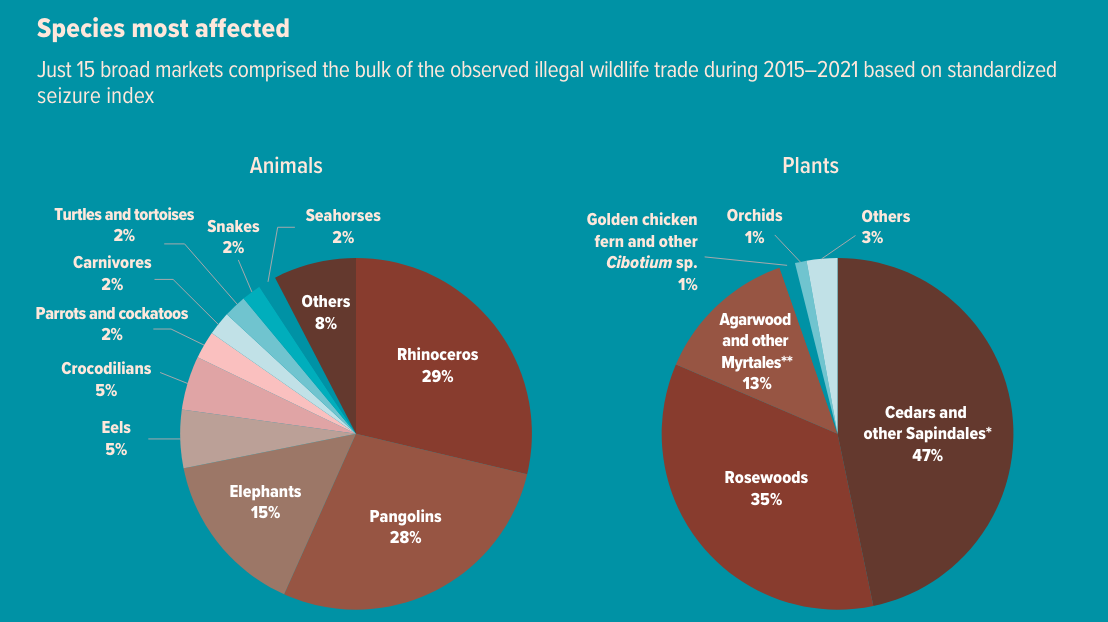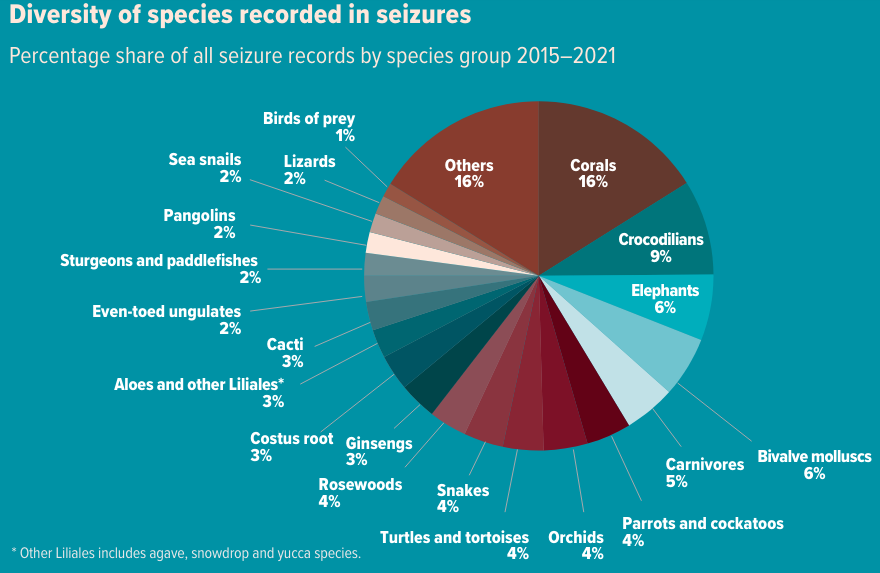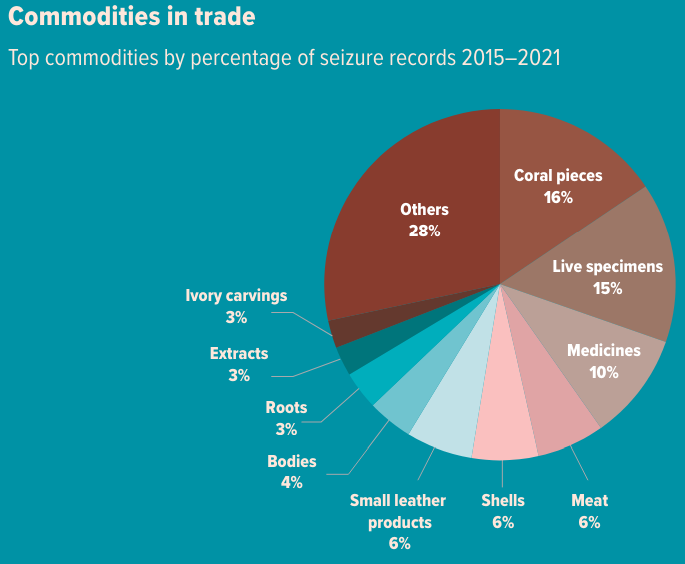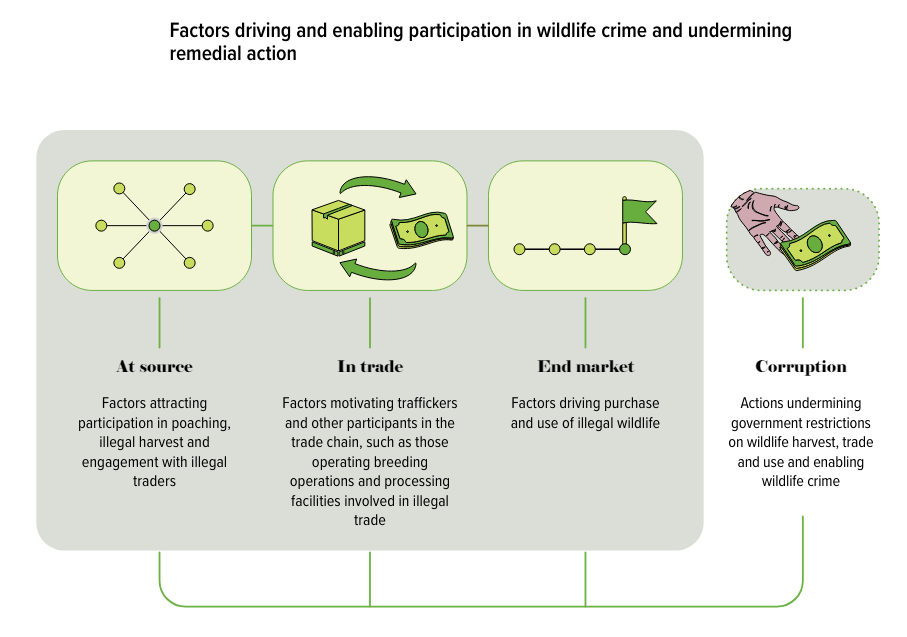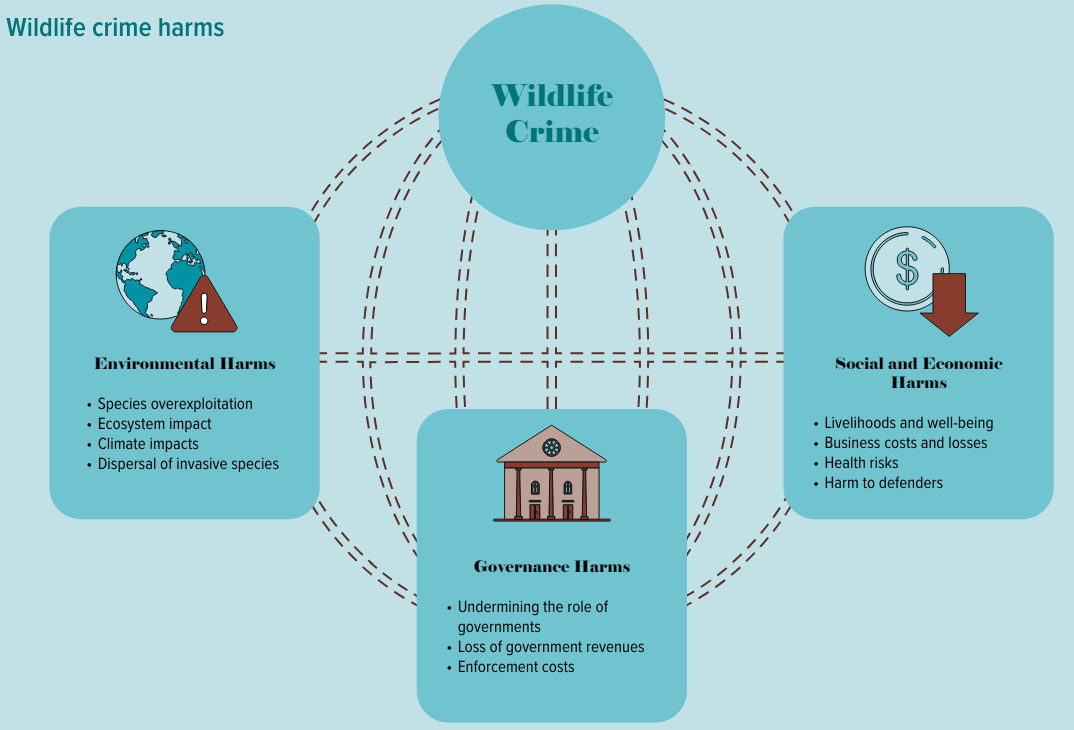Biodiversity & Environment
World Wildlife Crime Report 2024
- 20 May 2024
- 13 min read
For Prelims: Money Laundering and the Illegal Wildlife Trade, Organized Crime, Pangolin, Rhino Poaching.
For Mains: Organised crime and Wildlife Trafficking, Wildlife Conservation
Why in News?
The UN Office on Drugs and Crime (UNODC) has recently released the 3rd edition of a report titled the World Wildlife Crime Report 2024.
- It provided a comprehensive analysis of the illegal wildlife trade from 2015 to 2021.
United Nations Office on Drugs and Crime
- It was established in 1997 and was named as a United Nations Office on Drugs and Crime (UNODC) in 2002.
- It acts as the Office for Drug Control and Crime Prevention by combining the United Nations International Drug Control Program (UNDCP) and the Crime Prevention and Criminal Justice Division of the United Nations Office at Vienna.
What are the Key Highlights of the Report?
- Trafficking in Animal and Plant Products:
- The rhino (animal) and the cedar (plant) - most affected by global illegal wildlife trade during 2015-2021.
- Rhino horn - largest portion of the illegal animal trade at 29%, followed by pangolin scales at 28% and elephant ivory at 15%.
- Other illicitly traded animal species - Eels(5%), crocodilians(5%), parrots and cockatoos(2%), carnivores, turtles and tortoises, snakes, and seahorses.
- Major illegally traded plants - Cedars and other Sapindales like mahogany, holy wood, and Guiacum made up the biggest market at 47%, followed by rosewoods at 35% and agarwood and other myrtales at 13%.
- The rhino (animal) and the cedar (plant) - most affected by global illegal wildlife trade during 2015-2021.
- Commodities in Trade:
- Among the commodities, coral pieces were found the most and comprised 16% of all seizures during 2015-2016; live specimens - 15%, while medicines made of animal products constituted 10% of all seizures.
- Bone Processing to Move to the Source Nations:
- Report highlighted that traditionally, bones are processed in destination countries (Far East) but may now be processed closer to where the animals are sourced (Africa, Latin America, Asia).
- This is concerning because it would be Easier to traffic as processing like boiling bones into paste makes it easier to smuggle, it would be unknown if this is for local use, export, or both.
- The report notes concerns about substituting lion and jaguar bones for tiger bones, which are highly valued in traditional Chinese medicine.
- Off-Track from SDG Goal No.15.7:
- In 2024, the UNODC introduced a new indicator to track progress on SDG target 15.7, which aims to stop illegal wildlife trafficking.
- Rising Illegal Trade suggests that the proportion of illegal wildlife trade compared to all wildlife trade (legal and illegal) has been increasing since 2017.
- The problem worsened during the Covid-19 pandemic (2020-2021), with wildlife seizures reaching their highest levels at 1.4-1.9% of global trade.
- Compared to 0.5-1.1% in previous years, the rise in illegal wildlife trade suggests the world is not on track to achieve SDG target 15.7 by 2030.
What are the Factors Responsible for Wildlife Crime?
- Organised Commercial Illegal Sourcing:
- Organised crime groups are involved in activities such as elephant and tiger poaching, illegal fishing, and logging by operating remotely and often converging with other criminal enterprises, utilising power relationships, corruption, illicit firearms, and money-laundering opportunities.
- Throughout the trade chain, organised crime is evident in specialised roles like export, import, brokering, storage, breeding live specimens, and interfacing with processors.
- Supplementary Livelihoods and Opportunism:
- While big criminal groups might be behind some trafficking, there are also many poor people who are just trying to make ends meet.
- Sometimes, poaching happens because people are desperate to protect their crops or livestock from wild animals.
- Black Markets Create New Demands:
- When legal uses of a product decline, illegal traders might invent new ways to use it to keep selling.
- For luxury items like rare animals, plants, or endangered species trophies (ivory, big cat skins), scarcity can actually drive up demand in illegal markets, attracting more buyers.
- Corruption:
- It significantly undermines efforts to disrupt and deter wildlife trafficking, ranging from bribery at inspection points to higher-level influence on permit issuance and legal decisions.
- Despite legislation addressing corruption offering strong investigative powers and potentially higher penalties, prosecution of wildlife trafficking organisers under such laws is uncommon.
- Cultural Roots of Poaching:
- People don't just poach wildlife for money as sometimes it's part of their culture; research in the periphery of Chinko reserve in the Central African Republic revealed that some individuals view elephant hunting as part of their cultural identity, symbolising bravery and manhood, and passed down through generations.
What are the Impacts of Wildlife Crime and Trafficking?
- Environmental Impacts:
- Species Overexploitation: Wildlife crime leads to degradation of biodiversity through overexploitation, leading to population reductions and extinction threats. Species diversity is vital for functioning ecosystems.
- Ecological Impact: Overexploitation of wildlife can lead to long-term ecological problems such as sex-ratio imbalances and slowed reproduction rates.
- Population reductions from trafficking can disturb species interdependencies and essential ecological functions such as food chain and food web.
- Dispersal of Invasive Species: Illegal wildlife trade can contribute to the introduction of non-native species into new environments, potentially leading to invasive species that harm native ecosystems and natural resources.
- Social and Economic Harms:
- Well-being and Livelihoods: Wildlife crime, including illegal trade, undermines nature's benefits, impacting food, medicine, energy, and cultural values.
- A World Bank study estimated global economic losses from illegal wildlife trade at USD 1–2 trillion per year, largely from the value of ecosystem services not priced by markets.
- Private Sector Costs and Losses: Wildlife crime harms economies by increasing costs and losses for businesses in the legal wildlife trade and related services.
- It reduces resource access, causes unfair competition, damages reputations, and incurs extra legality verification costs.
- Health Risks: Wildlife trade poses significant risks of disease transmission to both humans and animals, as well as threats to natural ecosystems, livestock, and agricultural systems.
- Harm to Environmental Defenders: Police, customs, wildlife rangers are also vulnerable to harassment, violence by poachers, and even loss of life.
- Well-being and Livelihoods: Wildlife crime, including illegal trade, undermines nature's benefits, impacting food, medicine, energy, and cultural values.
- Governance Harms:
- Undermining the Rule of Law: Illegal wildlife trade undermines the rule of law and weakens natural resource management and criminal justice responses.
- Corruption facilitates this trade, compromising legislation and political stability. Additionally, money laundering is linked to wildlife crime, though financial investigations are limited.
- Loss of Government Revenues: Wildlife crime causes significant government revenue losses in source countries by evading legal harvest fees, taxes, and tourism income.
- Financial Costs of Enforcement: Wildlife crimes have driven increased government spending on conservation, law enforcement, and criminal justice globally.
- Undermining the Rule of Law: Illegal wildlife trade undermines the rule of law and weakens natural resource management and criminal justice responses.
What Measures Can be Taken to Effectively Reduce Wildlife Crime?
- Banning Illegal Wildlife Products:
- This approach aims to reduce demand by making it illegal to possess or trade goods derived from illegally obtained wildlife.
- For example, banning ivory products would discourage the killing of elephants for their tusks.
- Strengthening Domestic Regulations:
- India's existing laws like the Wildlife Protection Act (1972), Environment (Protection) Act (1986) and Biological Diversity Act (2002) need stricter enforcement and improved implementation across various government levels.
- Penalties for violating wildlife protection laws should be effectively implemented.
- Effective Funding for Wildlife Protection:
- While funding may exist, better allocation and management of resources are crucial. Funds should directly support wildlife protection agencies like park rangers and anti-poaching units.
- Additionally, involving local communities in conservation efforts and providing them with financial incentives can increase their participation in preventing wildlife crime.
- Public Awareness and Empowerment:
- Raising public awareness about the consequences of wildlife trafficking is essential. Educating citizens about the value of wildlife and the impact of illegal products can decrease demand.
- This fosters a sense of responsibility and encourages individuals to report suspicious activity to authorities.
What are the Legal Frameworks for Wildlife Conservation in India?
- Constitutional Provisions for Wildlife:
- The 42nd Amendment Act, 1976 placed the subject of Forests and Protection of Wild Animals and Birds under the purview of both the central and state governments, transferring it from the State List to the Concurrent List.
- Article 48 A in the DPSP mandates that the State shall endeavour to protect and improve the environment and to safeguard the forests and wildlife of the country.
- Article 51 A (g) of the Constitution states that it shall be the Fundamental Duty of every citizen to protect and improve the natural environment including forests and Wildlife.
- Legal Framework:
- Global Wildlife Conservation Efforts to which India is a Party:
- Convention on International Trade in Endangered Species of Wild Fauna and Flora (CITES)
- Convention on the Conservation of Migratory Species of Wild Animals (CMS)
- Convention on Biological Diversity (CBD)
- The Wildlife Trade Monitoring Network (TRAFFIC)
- United Nations Forum on Forests (UNFF)
- International Union for Conservation of Nature (IUCN)
- Global Tiger Forum (GTF)
|
Drishti Mains Question: Highlight the challenges and opportunities in combating wildlife trafficking. Suggest a multi-pronged approach for India to address this issue effectively. |
UPSC Civil Services Examination Previous Year Question (PYQ)
Prelims
Q. Consider the following statements in respect of Trade Related Analysis of Fauna and Flora in Commerce (TRAFFIC): (2017)
- TRAFFIC is a bureau under United Nations Environment Programme (UNEP).
- The mission of TRAFFIC is to ensure that trade in wild plants and animals is not a threat to the conservation of nature.
Which of the above statements is/are correct?
(a) 1 only
(b) 2 only
(c) Both 1 and 2
(d) Neither 1 nor 2
Ans: (b)
Mains
Q. Coastal sand mining, whether legal or illegal, poses one of the biggest threats to our environment. Analyse the impact of sand mining along the Indian coasts, citing specific examples. (2019)

